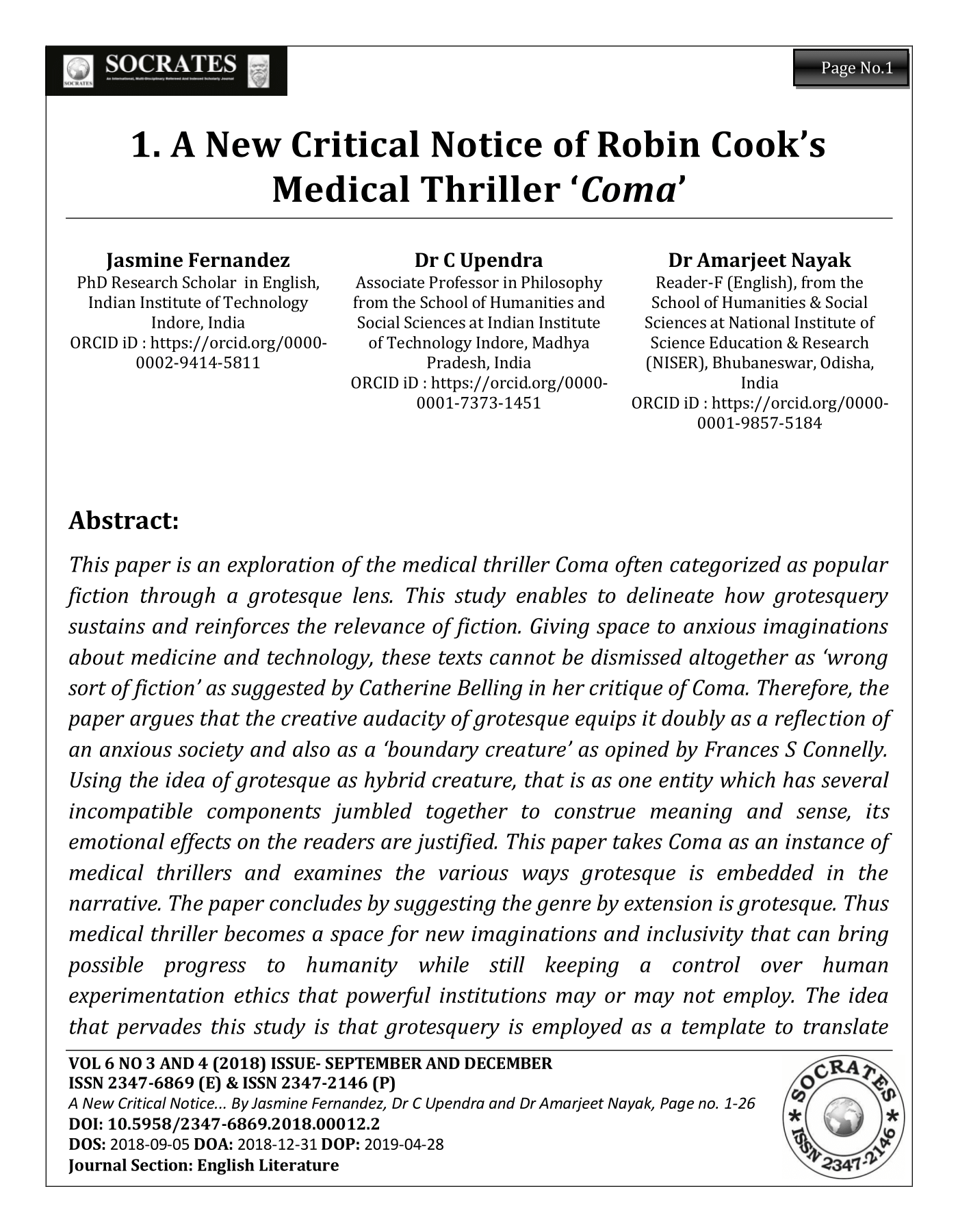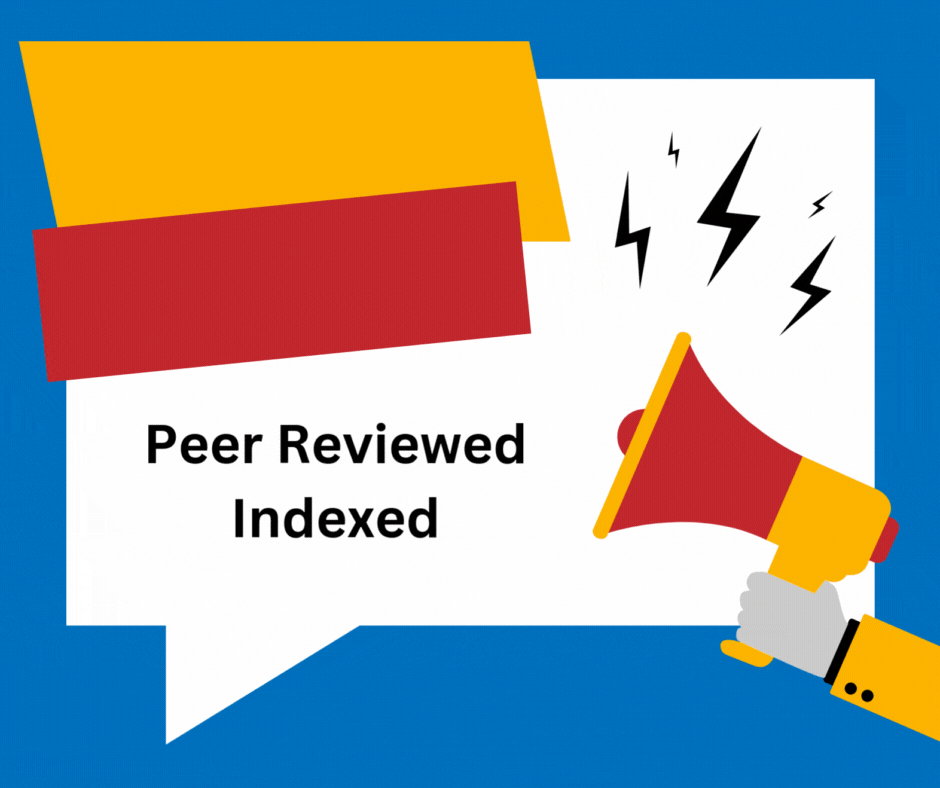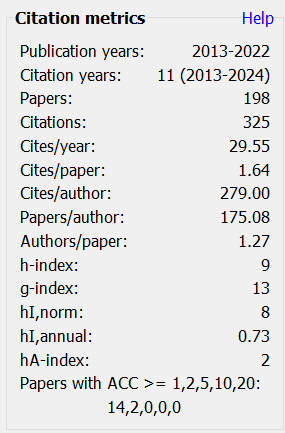A New Critical Notice of Robin Cook’s Medical Thriller ‘Coma’
DOI:
https://doi.org/10.5958/2347-6869.2018.00012.2Keywords:
Grotesque, Coma, Medical thriller, Popular fiction, BioethicsAbstract
This paper is an exploration of the medical thriller Coma often categorized as popular fiction through a grotesque lens. This study enables to delineate how grotesquery sustains and reinforces the relevance of fiction. Giving space to anxious imaginations about medicine and technology, these texts cannot be dismissed altogether as ‘wrong sort of fiction’ as suggested by Catherine Belling in her critique of Coma. Therefore, the paper argues that the creative audacity of grotesque equips it doubly as a reflection of an anxious society and also as a ‘boundary creature’ as opined by Frances S Connelly. Using the idea of grotesque as hybrid creature, that is as one entity which has several incompatible components jumbled together to construe meaning and sense, its emotional effects on the readers are justified. This paper takes Coma as an instance of medical thrillers and examines the various ways grotesque is embedded in the narrative. The paper concludes by suggesting the genre by extension is grotesque. Thus medical thriller becomes a space for new imaginations and inclusivity that can bring possible progress to humanity while still keeping a control over human experimentation ethics that powerful institutions may or may not employ. The idea that pervades this study is that grotesquery is employed as a template to translate meanings and interpretations of medical thrillers. Through multiple responses as elicited by the grotesque, these thrillers engage with readers differently and hence produce varied responses. This enables us to project the importance and usefulness of the medical thriller genre.
DOI: 10.5958/2347-6869.2018.00012.2
Downloads
Metrics
References
Argiro, L., & Holt, E. G. (1961). "A Documentary of Art History." Art Education, 14(2), 22
Bakhtin, M. (1984). Rabelais and His World. Trans. Hélène Iswolsky. Indiana University Press.
Belling, C. (2010). The Living Dead: fiction, horror, and bioethics. Perspectives in biology and medicine, 53(3), 439-451.
Cantwell, A. (1988). AIDS and the Doctor of Death: An Inquiry into the Origin of the AIDS Epidemic. Aries Rising Press.
Connelly, F. S. (2012). The Grotesque in Western Art and Culture. The Image at Play, 62.
Cook, R. (2001). Coma: a novel. Bell Books.
Doniger, W. (1996). Transplanting myths of organ transplants. Organ transplantation: meanings and realities, 194-220.
Erikson, E. H. (1972). “Play and Actuality.” Play and Development.
Fuβ, P. (2001). Das Grotesque: Ein Medium Des Kulturellum Wandels. Bohlau.
Goodwin, J. (2009). Modern American grotesque: literature and photography. The Ohio State University Press.
Greenberg, G. (2003, August 13). “As Good as Dead: Is There Really Such a Thing as Brain Death?” The New Yorker, 36–41.
Grotesque | Definition of grotesque in English by Oxford Dictionaries.
Harpham, G. G. (2006). On the grotesque: Strategies of contradiction in art and literature. Davies Group Publishers.
Kayser, W. (1981). The Grotesque in Art and Literature. Columbia University Press.
Paulson, R. (1983). Representations of Revolution (1789-1820).
Sharp, L. A. (2007). Bodies, commodities, and biotechnologies: Death, mourning, and scientific desire in the realm of human organ transfer. Columbia University Press.
Stookey, L. L. (1996). Robin Cook: A critical companion. Greenwood Publishing Group.
Thomson, P. (1972). The Critical Idiom 24. The Grotesque
Trivedi, H. L. (1990, June). Hindu religious view in context of transplantation of organs from cadavers. In Transplantation Proceedings (Vol. 22, No. 3, pp. 942-942). 25 VAN ZANT ST, E NORWALK, CT 06855: APPLETON & LANGE.
Wollstonecraft, M. (1792). A Vindication of the Rights of Woman: With Strictures on Political and Moral subjects. By Mary Wollstonecraft. J. Johnson.

Downloads
Published
How to Cite
Issue
Section
Categories
License
Copyright (c) 2019 Jasmine Fernandez, Dr C Upendra and Dr Amarjeet Nayak

This work is licensed under a Creative Commons Attribution-NonCommercial 4.0 International License.
Revised Copyright/CC license that applies to all the articles published after 05-02-2017
Attribution-NonCommercial 4.0 International (CC BY-NC 4.0)

Copyright/CC license that applies to all the articles published before 05-02-2017
Attribution-Non Commercial-No Derivatives 4.0 International (CC BY-NC-ND 4.0)

Author(s) will retain all the right except commercial and re-publishing rights. In the case of re-publishing, they will have to obtain written permission from the journal. Additional licensing agreements (Creative Commons licenses) grants rights to readers to copy, distribute, display and perform the work as long as you give the original author(s) credit, they can not use the works for commercial purposes and are not allowed to alter, transform, or build upon the work. For any reuse or distribution, readers and users must make clear to others the license terms of this work. Any of these conditions can be waived if you get permission from the copyright holders. Nothing in this license impairs or restricts the authors’ rights. To view a copy of this license, visit http://creativecommons.org/licenses/by-nc-nd/4.0/ or send a letter to Creative Commons, 171 Second Street, Suite 300, San Francisco, California, 94105, USA.
Research Papers published in SOCRATES are licensed under an Attribution-NonCommercial-NoDerivatives 4.0 International (CC BY-NC-ND 4.0)
















